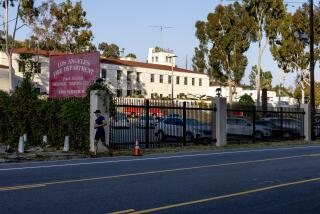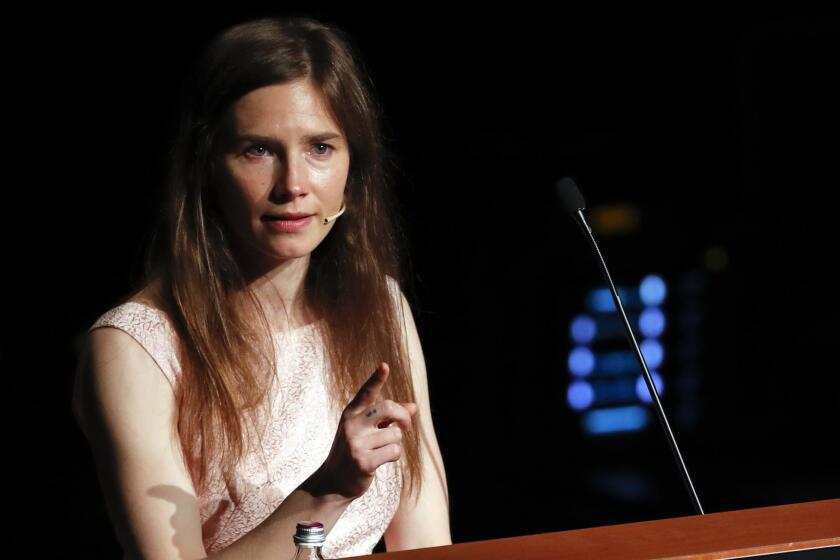Weather is their only business
- Share via
THE Weather Channel: It’s not just for motel rooms and eccentrics anymore.
With handsome hurricane hunters, new vocabulary words and major disasters provided by nature itself, its viewership has spiked during this historic weather period. But the Atlanta-based channel, already a closet addiction for many people, wants more. A makeover is in progress to emphasize “viewers’ emotional connection with the weather” and to encourage a more sophisticated audience to stick around for programs that explore the feelings, the meaning and even the politics of the weather.
Last week, for example, days before Hurricane Rita’s expected landfall, the Weather Channel was ready with heart-pumping music and graphics announcing “Hurricane Central.” Continuous reports were being filed from trusty “Hurricane Hunters” -- Jim Cantore in Houston, Stephanie Abrams in Galveston, Jeff Morrow in Surfside and Mike Bettes in Freeport. Back in the studio, Steve Lyons, framed by moving tapes of information, was using charts and graphs of swirling 170-mph winds to explain the “stadium effect” of what was then a Category 5 hurricane -- technical terms that have in recent weeks begun rolling easily off the tongues even of couch potatoes with scant interest in science.
Even before the hurricanes, some of the Weather Channel’s reporters -- good looking L.L. Bean-attired experts often shown on sea walls in their slickers and microphones against a backdrop of palm trees nearly horizontal from gale-force winds -- have gained their own online fan clubs. The channel’s newly launched weather blog, meanwhile, helped link people trying to reconnect with family and friends evacuated after the hurricane. On Monday, Aug. 29, the channel recorded 7 million visitors to www.weather.com, the second-highest day in the site’s history.
Patrick Scott, president of the Weather Channel Networks, wasn’t surprised. With some of television’s most dramatic, continuous and real reality programming, TWC has been attracting numbers “lots of channels would envy,” Scott said. Almost a month earlier, on Aug. 28, as Hurricane Katrina was making landfall, the Weather Channel set an all-time total-day record for itself with a 2.2 rating, reaching an average of 1.9 million households. Fox News Channel had a 2.1 rating, followed by CNN with 1.0 and MSNBC with 0.5.
“Historically, we’ve had spikes in viewership around landfall in hurricanes anywhere, particularly if they’re approaching some major population center,” he said. But now he wants people to stay longer than the few minutes required to see if they need an umbrella or if their plane might be delayed. About 60 million viewers check in at the Weather Channel each month for at least three minutes; they watch an average of 18 minutes in the morning and 12 minutes at night. “Our aim is to keep those people longer,” Scott said. “Adding half a minute would be very good indeed.”
In order to grow into a bona fide niche cable TV operation on a par with the Discovery Channel or Animal Planet, the Weather Channel is sure to face challenges, such as navigating the new politics of weather. Climate change has become a hot potato since the Kyoto Protocol agreement on global warming, Scott said. “Just hiring a climatologist was difficult. There are people in the field who clearly have an agenda.” He said TWC would not avoid such politically charged subjects in the future, though “we won’t do them in a highly charged manner.”
One of the channel’s practices, accepting funding from government agencies, has drawn suspicion. In the past, government agencies, including the Environmental Protection Agency, have sponsored particular documentaries or programs, such as one that explained new satellite forecasting systems. Under the terms of the arrangement, the government has no editorial control, Scott said.
Scott said the channel would not accept funding for a program on global warming, but the channel regularly covers the issue. The Weather Channel’s climatologist, Heidi Cullen, hosts “Forecast Earth” (to return Oct. 16), a look at long-term weather patterns. Cullen also has segments on the evening edition and recently interviewed the author of a highly political report suggesting that global warming is linked to the intensity of the last two hurricanes in the Gulf of Mexico.
Some TV analysts would like to see even more in this vein. “You could argue the Weather Channel could take a leadership role in reporting environmental issues,” said Robert Thompson, director of Syracuse University’s Center for the Study of Popular Television. “It would make sense. The environment and the weather are certainly intricately connected to each other. It would be interesting to see them do advocacy journalism -- one of the things that is sorely lacking in broadcast.”
And like all niche cable networks, Thompson said, TWC eventually needed to expand its schedule with original programming. Just as MTV expanded beyond music videos, TWC could succeed, he said. “It’s not like they have a boring subject.”
Indeed, other lifestyle and documentary programs are underway. The unprecedented major hurricanes have twice delayed the launch of the new “Weekend View,” a Saturday morning lifestyle show designed to help viewers plan their weekends. The channel has already introduced long-form documentaries on extreme weather, such as “Storm Stories,” an evening show with eyewitness accounts, historical perspectives, expert commentary and dramatic footage.
More are planned. One new show, “It Could Happen Tomorrow,” will focus on historical disasters, exploring what would happen if the same natural events occurred in the same location in modern times. The pilot won’t air, however, Scott said, because it was set in New Orleans. The scenario producers had laid out hypothetically had “played out before our very eyes,” he said.
For most of its 23-year history, the Weather Channel, one of several media entities owned by Landmark Communications, has had a low profile. Since Scott arrived five years ago, it has moved away from the “standardized wheel” of topical and local forecasts and picked up the pace. Most of the changes will take place in the evening and aim to provide “knowledge seekers” with information. Morning programs will stick to the facts. A rolling presentation of the latest information will still continue 24/7.
According to its own research, viewers give the channel high marks for credibility.
“People believe we are trustworthy because that’s all we do. It’s our sole focus,” said Cindy Jones, vice president of consumer marketing.
It’s difficult to prove, of course. But unlike weather segments on other news channels, Scott said, TWC has its own “proprietary forecasting system and 23 years of institutional knowledge about how to present weather to people.” It has a staff of more than 120 degreed meteorologists. Besides the balding Lyons, many in-studio meteorologists are becoming glamorously dressed, bejeweled and made up. A few long-standing reporters, Scott would not divulge their names, are actually not meteorologists, but TWC’s research shows that the audience can’t tell the difference.
One criterion for on-air reporters, he said, is a sense of passion for the weather. “One characteristic that is universal is when you ask them about their interest in weather, they say, ‘You know what, I can’t explain it, but it’s been this way since I was 5, watching lightning from my grandmother’s porch in Oklahoma.’
While other networks have attempted to send anchors into extreme weather, Scott said, “they often run out of things to say. They don’t know enough about it. You can only say, ‘My gosh, it’s windy’ so many times. Jim Cantore has been doing it for 12-plus years.”
TWC’s meteorologists are often requested to make vignettes for such shows as “Today,” “Good Morning America” and even “Entertainment Tonight.” During the last hurricane, other news shows borrowed the Weather Channel’s video segments or reporters.
“The weather has a meaningful place in people’s lives,” Jones said. People have rich weather memories related to the senses of smell and sound, she said. “Weather not only affects people’s moods, it tells them what’s possible. How to spend a day.”
“There is something almost primeval about it,” Scott added. “It’s a demonstration of the smallness of humankind when you see something like Katrina. We really have no concept of the might and power of weather.
“I sometimes say to my friends, it’s programming by God,” Scott said.
But that’s one place the Weather Channel won’t go, he said. “We’re staying at the emotional connection level.”
More to Read
The complete guide to home viewing
Get Screen Gab for everything about the TV shows and streaming movies everyone’s talking about.
You may occasionally receive promotional content from the Los Angeles Times.






